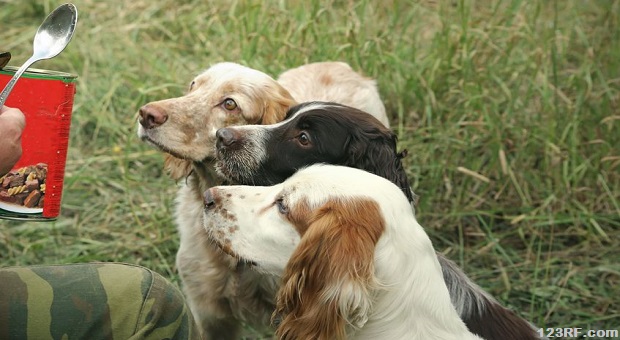Our pets are a part of our lives, but people often forget that they will have needs if SHTF too. They’ll still need to eat and they may get sick. Storing back pet food and common medications is a necessary part of your prepping.
Pets can be useful in survival situations; they can warn you that storms are coming, they can defend your home, and they can perform a multitude of services to help you survive. Today we’re going to talk more about prepping with pets.
Pets are Weather Radars
Dogs, cows, horses, and other livestock can tell you when storms are approaching.
They get skittish and may begin to gather in herds facing the same direction.
Depending on the type of animal you have, you may get a few hours’ notice to prepare.
We could write an entire book on this topic, but for now, just know your animals and what to look for, and read our previous article about warning signs on animals.
When prepping for pets, there are several items that you’ll need to stockpile. Just as with your other prepping efforts, try to choose multi-purpose items that store well. Here are some examples.
- Kitty litter – this can be used for more than giving kitty a place to go. You can also use it to absorb odors in your own waste system. The active ingredient is bentonite, an absorbent clay with unique clumping properties. It’s also a sealant that can be used to seal koi or algae ponds. Since you can add water to it to make a slurry, it may also be useful to seal cracks to keep the heat in and the cold out sodium bentonite can also help heal wounds and boils by drawing toxins out. Make sure that you buy unscented kitty litter with only bentonite (or bentonite and diatomaceous earth). Avoid the kind that reduces dust, too.
- Pet Food. This is just an opinion and I’m sure that we’ll have a lively discussion about it, but you may want to consider storing foods such as tuna or low-sodium beef stew that you may find on sale BOGO (or even free with coupons) in place of part of your pet food. That way, your pet food is also edible by people, and frankly will cost less than buying canned dog or cat food. It may not be ideal now but if SHTF, it’ll do!
- Leashes and Collars. Make your leashes and collars from paracord that can be disassembled and used in an emergency.
Training Pets for Emergencies
 There are several reasons why you should provide your pet with training in case of emergency.
There are several reasons why you should provide your pet with training in case of emergency.
Dogs or even birds can provide protection, horses can be used for work or as a means of transportation and even pigs can be trained.
But the keyword is training. Just as your animals can help you if properly trained, a barking dog or a bucking horse can be your downfall.
Here are some basic training categories that you should provide when prepping for pets.
- Obedience. Your dogs should be trained to come, to be quiet and to sit/stay. In case you’re hiding, a barking dog can be a dead giveaway that you’re there. Your horse or mule should be taught to stand still to be saddled and mounted and to take a bit without a fight. You can lose valuable time chasing it in circles trying to mount.
- Desensitization. Many things will be strange to your animals. The sounds of guns, flapping tarps, the smell of smoke; all of these can frighten animals. Get them used to all of this before SHTF so that they will remain obedient, useful and safe if SHTF.
- Service. Train your animals to be of use. Dogs can pull people or small carts, carry backpacks and act as protectors. Horses, mules or donkeys can be ridden or used as plow animals and can pull the sick or wounded. Pigs can be trained to defend the house or even carry items. Birds can even be trained to protect you or to act as an alarm. Train your pets to serve a purpose if at all possible; otherwise they’ll just be extra mouths to feed.
Pets are awesome companion animals but when you’re fighting for your survival, they can quickly become a burden. If you only have a small space to store your stockpile, even putting back pet food can take away space from what you need to store your own food. By storing food that both people and animals can eat when prepping for pets, you’re killing two birds with one stone.
It’s imperative that you train your animals so that they don’t put you in danger and can actually help you in a survival situation. Research what your pets can do, then either learn how to train them or work with a professional trainer.
In a SHTF situation, properly training your pets may just be the difference between surviving, or perishing. If you have other pet-related tips, please share them with us in the comments section below.
 This article has been written by Theresa Crouse for Survivopedia.
This article has been written by Theresa Crouse for Survivopedia.




































































I have been into prepping for several years now. Last year I obtained a Catahoula Bulldog puppy and then joined a volunteer Search and Rescue Team in order to get the dog and me certified in tracking. We now have our certification with The Police Working Dog Association (NAPWDA). We just got a Cane Corso puppy to also train him for the same purpose and for protection. The Catbull also has her Good Canine Certification with the AKC. Both dogs will be valuable as protection and for finding a team member when things get bad. I would recommend this training for anyone who loves dogs and uses them for the jobs that they were bred to do. Another advantage is, when they are certified as police working dogs, you can take them everywhere you go and if anyone harms them it is a violation of the law.
I couldn’t agree more about training animals as partners in survival. I’ve trained my dogs to whisper so they have 3 levels of alerts. It’s my job to know from their alerts what is ‘out there’. Each also is learning to pull a cart, size dependent on dog size. Many are surprised when they see what different tasks animals can do.
Thanks for the post. Great reminder.
I am impressed by the thoroughness of this post. You seem to have covered about everything. I will agree to disagree about canned pet cat food, however, The higher quality brands are palatable by humans. Along with canned cat food, I have a much larger store of bagged dry cat food, which stores easily, lasts longer, and is much cheaper by the meal. I have had a “crunch” of it, and you do not want to eat it yourself! Though not a prepper, I find quite a lot of useful informtion here, in case of the unexpected.
Longer term, if you are going to hunt then the dogs can eat the parts you won’t. You can also give them some of the bone broth to supplement their food
Pigs will eat pretty much anything.
Contrary to popular belief goats are actually fussy eaters, but they can be used as pack animals or pull carts
Equines (Horses, donkeys, etc) will graze, but they can be skittish, for this reason I’ve read of people using Lamas or Alpacas instead, as they are inclined to be calmer and seem to think their way out of problems, plus they will protect your birds from predators.
Cats will revert to their feral routes and hunt, so you rarely need food for them, even in cities there is usually plenty of prey
The one thing I noticed is that, in common with many pieces on prepping with pets, is that one (very ??) important area has been omitted. That area is is learning about animal healthcare. we can all look at an animal and recognize that something is wrong (they are lethargic, off their food, irritable, etc) but that’s of no use to you or the animal if you don’t have any idea what that something is. So you need to at least have a knowledge of common ailments and treatments, which are specific to that animal. We can already treat some things because the treatment is the same as for us, things such as cuts, limping, eye irritation.
But, as an example, colic is uncomfortable for people, but it can kill your horse(s)
Alpacas need to eat 1-2% of body weight per day, so about two
60 lb (27 kg) bales of grass hay per month per
animal.
I really appreciate this article. I wish there was more practical discussion on dealing with, caring for and maintaining “pets” after SHTF. I came across this article in search of alternative (non-pharmaceutical) means to deworm cats, dogs, horses and other Livestock in a situation where access to purchased items is no longer available. Im still in search of that information.
Keep up the good works!